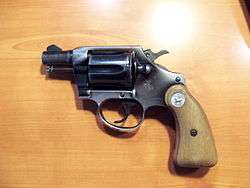Snubnosed revolver
A snubnosed revolver (colloquially known as a snubbie, belly gun or bulldog revolver) is any small, medium or large frame revolver with a short barrel, generally 3 inches or less in length. Smaller revolvers are often made with "bobbed" or "shrouded" hammers, and there are even "hammerless" models, all allowing the gun to be drawn quickly with little risk of it snagging on clothing. The shrouded and hammerless models may even be fired through a coat or jacket pocket.[1] The design of these revolvers sacrifices power and range for maneuverability and concealment.
Snubnosed revolvers were extremely popular in the United States until the 1950s and 60s, when most states passed laws limiting or prohibiting the carry of concealed weapons. However, the passage of "shall issue" firearms license laws in the mid-1990s, creating new markets for small, simple, reliable, concealed carry firearms, and resulted in a resurgence in the popularity of snubnosed revolvers in the United States,
The increased demand for snubnosed revolvers has been met with the introduction of numerous new models from Smith & Wesson, Colt, Ruger, Taurus, and other manufactures. While most were made of traditional carbon steel, stainless steel, and lightweight aluminum alloys that had been in use for decades, some of the newer models used high-strength, lightweight metal alloys such as titanium and scandium. More recently even polymer frames have been used.
Most manufactures now produce snubnosed revolvers in far more powerful calibers than before, such as .357 Magnum and .44 Magnum. Some companies even make .454 Casull, .480 Ruger, .460 S&W Magnum, .500 S&W Magnum and .410 gauge snubnosed revolvers. There are also snubnosed revolvers chambered for semi-auto pistol cartidges such as 9×19mm Parabellum, .40 S&W and .45 ACP, and loaded via moon-clips.
History
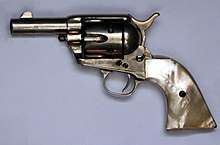
The first snubnosed revolvers were the 6 shot, 3" barreled Colt Single Action Army revolvers made without ejector rods, officially called the "Sheriff's Model," and the "Storekeeper's Model",[2] also unofficially known as the "Banker's Special."[3] The 4¾" barrel models were known as the "Gunfighter" model.[4] The 5½" barrel models were called the "Artillery," and the "Cattleman" or "Cowboy" models.[5] And, 7½" barrel models were called the "Army", the "Cavalry" and the "Standard" models.[6]
The British Bull Dog was a popular type of 5-shot, solid-frame, double action, pocket revolver introduced by Philip Webley & Son of Birmingham, England, in 1872, and subsequently copied by gunmakers in continental Europe and the United States.[7] It featured a 2.5" barrel and was chambered for .442 Webley or .450 Adams cartridges. Webley produced smaller scaled .320 Revolver and .380 calibre versions later, but did not mark them with the British Bull Dog name. The term "bulldog revolver" would go on to become synonymous with large caliber "snubnosed revolvers."
The Colt M1877 Double Action Revolver is a 6-shot, double-action revolver manufactured by Colt from January 1877 to 1909 for a total of 166,849 revolvers. The Model 1877 was offered in three calibers, which lent them three unofficial names: the .38 Long Colt "Lightning", the .41 Colt "Thunderer", and the .32 Colt "Rainmaker".[8][9] The M1877 was the first successful US-made double-action cartridge revolver.[9] The M1877 was offered from the factory in two basic finishes: nickel-plated or a case-hardened frame with a blue barrel and cylinder. The revolver was available in 2.5" and 3.5" barrel length and was available with or without the ejector rod and housing. The shorter barreled versions without the ejector rod were marketed as "Shopkeeper's Special".[8]
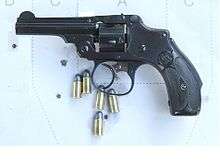
The Smith & Wesson Safety Hammerless models were produced from 1887 to just before World War II. It's small concealable , 5-shot, double-action revolver chambered in either .32 S&W or .38 S&W. They were most often produced with 2", 3" and 3.5" barrels.[10][11] These top-break revolvers were designed for fast reloading and concealed carry as the hammer was internal and would not snag on drawing the revolver from a pocket. They also had a grip safety. They were known as "The New Departure" to reflect the company's new approach to designing revolvers.[10] The design of these revolvers sacrifices power and range for maneuverability and concealment. Similar "hammerless" designs were manufacturers such as Iver Johnson and Harrington & Richardson and proved popular for concealed carry.

The FitzGerald Special, "Fitz Special", or "Fitz Colt" is a snubnosed revolver concept that was pioneered by John Henry Fitzgerald (AKA: "Fitz"), an employee of Colt Firearms from 1918 to 1944. Fitz Special revolvers are made by shortening the barrel to two inches, shortening the ejector rod, bobbing the hammer spur, removing the front half of the trigger guard, and rounding the butt. Reshaping the hammer and the butt allows the gun to be drawn quickly with little risk of the weapon snagging on clothing. The halved trigger guard facilitates quick trigger acquisition, even for shooters with large fingers or gloves. [12] Fitzgerald first came up with his concept sometime around the mid 1920s when he modified a .38 Special Colt Police Positive Special revolver, whose shortest available barrel length at the time was four inches. He later modified two .45 caliber Colt New Service revolvers in the same manner.[13] and was known to carry the pair in his front pockets. The FitzGerald Special was the precursor to the modern snubnosed revolver and specifically the prototype for the Colt Detective Special.
.jpg)
The Colt Detective Special is a carbon steel framed double-action, snubnosed, six-shot revolver. As the name "Detective Special" suggests, this model revolver was used as a concealed weapon by plainclothes police detectives. It's was made with either a 2" or 3" barrels. Introduced in 1927, the Detective Special was the first snubnosed revolvers produced with a modern swing-out frame. It was designed from the outset to be chambered for higher-powered cartridges such as the .38 Special, considered to be a powerful caliber for a concealable pocket revolver of the day.

The Smith & Wesson Model 10 or Military & Police, is a revolver of worldwide popularity. In production since 1899, it is a medium-sized, 6-shot, .38 Special, double-action revolver with fixed sights. Over its long production run it has been available with barrel lengths of 4", 5" and 6".[14] With the first snubnosed models with barrel lengths of 2", 2.5" and 3" being made in 1936.[14][15] Over 6,000,000 Model 10s have been produced over the years, making it the most popular handgun of the 20th century.[16]

The Smith & Wesson Model 36 was designed in the era just after World War II, when Smith & Wesson stopped producing war materials and resumed normal production. For the Model 36, they designed a small concealable, 5-shot, double-action revolver with a 2" barrel, that could fire the more powerful .38 Special cartridge. Since the older "Safety Hammerless" (I-frame) was not able to handle this load, a new frame was designed, which became the J-frame.
.jpg)
The new design was introduced at the International Association of Chiefs of Police (IACP) convention in 1950, and was favorably received. A vote was held to name the new revolver, and the name "Chiefs Special" won.[17] A 3" barreled version design went into production immediately, due to high demand. It was available in either a blued or nickel-plated finish.[18] It was produced as the "Chiefs Special" until 1957, when it then became the Model 36. In 1951, Smith & Wesson introduced the Airweight Model 37, which was basically the Model 36 design with an aluminum frame and cylinder. The aluminum cylinders proved to be problematic and were abandoned in favor of a steel cylinder.[18] Smith & Wesson would also introduced the J-frame Smith & Wesson Centennial (hammerless models) and Smith & Wesson Bodyguard (shrouded hammer) models. In the 1990s, S&W introduced 9mm Parabellum and .357 Magnum models. They would also introduce new models using high-strength, lightweight metal alloys such as titanium and scandium.
The Colt Cobra is a lightweight, 21 oz aluminum-framed, 6-shot, double-action revolver with a 2" barrel, not to be confused with the Colt King Cobra. The Cobra is chambered for .38 Special, .38 S&W, .32 S&W Long, and .22 LR. It was sold by Colt from 1950 until 1981.[19] In December 2016, it was announced that Colt would be producing a new run of the Colt Cobra with a steel frame and a fiber optic front sight. This model was released in early 2017.
.jpg)
The Smith & Wesson Model 12 is an aluminium alloy-frame version of the Model 10. It weighs 19 oz (524 g) unloaded. A 6-shot, .38 Special revolver it was made from 1953 to 1986 in both 2" and 4" barrel configurations. The Model 12 was Smith & Wessons answer to the Colt Cobra. Early models used an aluminum cylinder as well as frame.

Introduced in the early 1970s, the Model 15-2 became the best known and the best selling Dan Wesson Firearms revolver model to go into production. This 6-shot, .357 Magnum revolver uses a unique interchangeable barrel system, including a 2.5" snubnose barrel along with 4", 6", 8", 10", 12", and 15", partial or fully lugged shrouds with choices of solid or ventilated ribs, plus removable and interchangeable front sights. The Model 15-2 could be ordered as "Pistol Pacs" with 4 (or more) barrel/shroud sets shipped inside a fiberglass briefcase with barrel changing tool and clearance gauges; however, most pistols were sold with only one barrel, with the buyers able to purchase other barrels later. All barrels and shrouds within a model series are compatible, thus a Model 15-2 frame from the 1970s may be equipped with a barrel from the 1990s and shroud made in 2016. The 15-2 increased sales markedly over the earlier models, and were often seen in use with both target shooters and hunters. The Model 44 are large frame models in .44 Magnum with interchangeable barrels, including a 2.5" snubnose barrel.
Introduced in 1973, the Charter Arms Bulldog is a relatively inexpensive yet serviceable, no-frills, 5-shot, .44 Special or .45 Colt snubnosed revolver.[20][21] It was a top-selling gun during the 1980s and it's considered the companys' trademark weapon.[22] The Bulldog comes in multiple barrel lengths including 2.2", 2.5" and 3".[23][24] It has no sharp edges to contend with when carrying the weapon in a holster or a pocket.[25] The Bulldog is a solid-framed traditional double-action revolver, the cylinder is opened by pushing a release slide on the left of the gun, or in the original model by pulling the ejector rod. It features a concave sight. Its trigger pull, in both single and double-action modes, is quite light.[20][25] The Police Undercover model comes in .357 Magnum, while the Pittbull models come in .45 ACP, .40 S&W, and 9×19mm Luger. Charter Arms also makes a variety of smaller frame .38 Spacial snubnosed models known as the Undercover made in standard, bobbed, shrouded and hammerless models. Charter also produces the Mag Pug in .357 Magnum and .41 Remington Magnum.
.jpg)
The Taurus Model 85 is a small-frame, 5-shot, double-action revolver manufactured by the Brazilian firearm company Taurus International. Introduce in the 1980s, in the United States the guns are marketed for concealed carry and personal protection.[26] The Model 85 is available with either 2" or 3" barrels, is capable of firing +P rated .38 Special rounds. The Model 85 is available in several configurations. These include blued steel, stainless steel, polymer frame, and "Ultra-Lite" variants constructed of aluminum and titanium, with steel lock-work components.
Much like Smith & Wesson revolvers, Model 85s can come equipped with exposed, bobbed, shrouded and hammerless models. However, there are a number of significant internal differences between the Taurus 85 and similar Smith & Wesson revolvers.[27] Because of these differences, Taurus has been able to keep costs relatively low. However, those same differences can make customization of the Model 85 more expensive.[28] Taurus also makes a more powerful versions such as the Model 605 in .357 Magnum and the 9mm Parabellum Model 905.

In 1989, Smith & Wesson began to make a series of snubnosed models of the S&W Model 29, a large frame, six-shot, double-action revolver chambered for the .44 Magnum cartridge. The Backpacker with a 2.5" barrel, and the Mountain Gun and the Trail Boss had 3" barrels.[29] These guns were designed to be "carried often and shot little".[30]
The Ruger SP101 is a series of small-frame, double-action revolvers introduced in 1989 by the American company Sturm, Ruger as the smaller-frame counterpart to the GP100.. The SP101 is an all-steel-construction revolver with a spurred or spurless (double-action only) hammer. The SP-101 has barrel lengths of 21⁄4" and 31⁄16". The .38 Special, .357 Magnum, and 9×19mm Parabellum models hold 5-shots, while the .327 Federal Magnum and .32 H&R Magnum models hold 6-shots, and .22 LR model holds 8-shots.
The Smith & Wesson Model 500 Emergency Survival is a large frame, 5-shot, 2.75" barrel, .500 S&W Magnum, double action revolver with blaze orange Hogue grips. The Model 500 was built on the entirely new X-Frame, which was developed exclusively to handle the immense muzzle velocity and pressures generated by firing of the .500 Magnum cartridge.[31] It is among the most powerful revolvers in the world since its original release in 2003, and is marketed as "the world's most powerful handgun" by the manufacturer.[32] The Smith & Wesson Model 460 Emergency Survival is essentially the same gun in .460 S&W Magnum. It can also shoot .454 Casull and .45 Colt, and is easily identified by its neon yellow Hogue grips.
Introduced in 2005, the Ruger Alaskan is Ruger's first short-barreled, big-bore, six-shot, double-action revolver, intended for defense against large, dangerous animals.[33][34] The 2.5" barrel on the Alaskan ends at the end of the frame, and the scope bases are omitted.[33] The interchangeable front sight is replaced with a pinned-in ramp sight, but the adjustable rear sight is retained. The Alaskan is available in .44 Magnum, .454 Casull/.45 Colt, and .480 Ruger, with the .480 model originally a 6-shot, replaced in 2008 with a 5-shot model to aid in spent cartridge extraction.[33] All Alaskans feature a brushed stainless finish and a Hogue Tamer rubber finger groove grip, rather than the standard GP100 style.[33] The .454 and .480 versions have an unfluted cylinder while the .44 Magnum features a fluted cylinder.[33]

The Ruger LCR is a small, 5-shot, double-action revolver with a 1.875" barrel, built by Ruger and announced in January 2009. LCR stands for 'Lightweight Compact Revolver'. It incorporates several novel features such as a polymer grip and trigger housing,[35] monolithic receiver, and constant force trigger. At 13.5 oz (380 g),[36] the LCR is nearly 50% lighter than the stainless steel SP101[37] and only the barrel and fluted cylinder are made of stainless steel. The frame is aluminum alloy and synthetic glass-filled polymer finished in matte black with Synergistic Hard Coat. The LCR operates in double-action only (DAO) as the hammer is concealed within the frame handle's fire control housing and cannot be cocked prior to firing. In order to create a lighter trigger pull, it features a friction reducing cam. The LCR-357 chambered for .357 Magnum.[38] The Ruger LCR 22 an 8-shot .22 LR version. There are also a 6-shot .22 Winchester Magnum Rimfire and a .327 Federal Magnum version, as well as 5-shot a clip-fed 9mm Luger version.
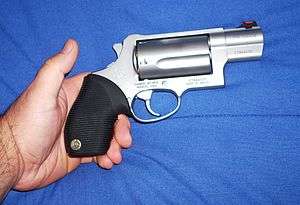

The Taurus Judge is a 5-shot, snubnosed (3 inch barrel), revolver introduced in 2006, by Taurus International, chambered for .410 bore shot shells and the .45 Colt cartridge. Taurus promotes the Judge as a self-defense tool against carjacking and for home protection.
The Smith & Wesson Governor is 6-shot, snubnosed (2.75 inch barrel), double-action revolver built on the Z-frame (a stretched N-frame) and utilizes a K-frame grip with a lightweight scandium alloy or stainless steel frame. Introduced in 2011, and similar to the Taurus Judge, the Governor can also fire 2 1⁄2-inch .410 shotgun shells, .45 Colt, and .45 ACP (with the use of supplied moon clips due to the lack of a rim on the auto pistol cartridges).[39]
Trail guns
All of the traits that make snubnosed revolvers ideal for concealed carry also make them excellent trail guns. So much so, that the .44 Magnum "Smith and Wesson Trail Boss" and "Ruger Alaskan" were specifically made for that purpose.[40] They are also capable of using a wide range .44 Special and .44 Magnum ammunition, including snake shot. As a result, these large caliber snubnosed revolvers can provide effective defense from snakes, to wolves, to mountain lions, even large brown bears.[41]
Small frame lightweight .38 Special and .357 Magnum revolvers are also ideally suited for hikers and backpackers.[42] Easily carried in a pocket, small holster or fanny-pack, snubnosed revolvers like the Smith & Wesson Model 340PD are ultra-light, 5 shot, .357 Magnums. Constructed of lightweight, corrosion resistant alloys, its cylinder is made of titanium, its frame and its barrel are made of scandium (an enhanced aluminum alloy), and its barrel has a stainless steel barrel liner. Unloaded it weighs only 12 ounces (340 g) and when loaded it remains under 1 pound (0.45 kg).[43] While not as powerful as .44 Magnum, a .357 Magnum can easily kill coyotes and large feral dogs.
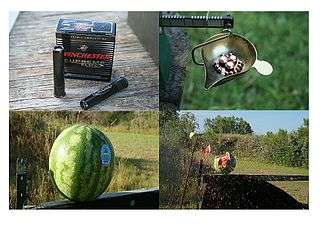
The Taurus Judge and the Smith & Wesson Governor are also high touted trail guns capable of firing .410 gauge shotgun shells and .45 Colt and for the Governor .45ACP ammo as well. When loaded with Winchester Supreme Elite .410 shells packed with three 71 grain disks and twelve BB pellets, these trail guns can kill anything from snakes to wolves.
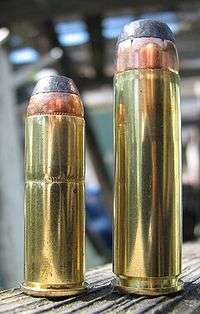
Like most big caliber handguns the S&W Model 500 Emergency Survival revolver is suitable for sport, hunting and survival applications. These high energy .500 S&W Magnum rounds can kill extremely large Brown bear, Polar bear and even the African Big Five.[44] The Model 500 can fire a bullet weighing 350 gr (22.7 g; 0.8 oz) at 1,975 feet per second (602 m/s) generating a muzzle energy of over 3,030 foot-pounds force (4.1 kJ). Commercial loadings are available in bullet weights ranging from 275 gr to 700 gr.[45] The Model 500 can produce massive amounts of recoil and supreme stopping power, this cartridge is unrivaled in power in the handgun world. The Model 500 is also capable of firing the shorter .500 S&W Special cartridge. The Smith & Wesson Model 460 Emergency Survival is essentially the same gun in .460 S&W Magnum. It can also shoot .454 Casull and .45 Colt.
Accessories
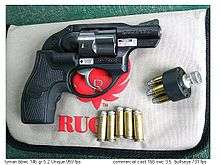
There are a surprising range of aftermarket accessories available for the snubnosed revolvers, including grips, speedloaders and holsters. There are also hammer shrouds and hammer shroud grips (Bianchi Lightning Grip) that convert standard exposed hammer revolvers to "bodyguard" models. The Pocket-Safe Hammer Shroud is a pop-on plastic device that covers the hammer, keeping it from snagging on clothing, and pops-off when the trigger is pulled. There are a wide range of lasers available with the Crimson Trace laser grips standing out among them. The Barami Hip-Grip is a "set of grips for revolvers with a paddle or wing added on the right-hand side. The wing hooks onto your belt and keeps the snubbie where you put it."[46]
See also
References
- ↑ https://www.usconcealedcarry.com/five-shot-snubnosed-revolver/ Gun Review: 5-Shot Snub-Nosed Revolver By Scott W. Wagner. 06/17/2015
- ↑ http://pdf.textfiles.com/manuals/FIREARMS/colt_single_action_army.pdf COLT SAFETY AND INSTRUCTION MANUAL. SINGLE ACTION ARMY REVOLVER SHERIFF'S AND STOREKEEPER'S MODEL REVOLVERS NEW FRONTIER@ SINGLE ACTION ARMY REVOLVER
- ↑ Repeating and Multi-Fire Weapons: A History from the Zhuge Crossbow Through the AK-47. Gerald Prenderghast. McFarland Books, Mar 30, 2018. p 90
- ↑ https://www.americanrifleman.org/articles/2016/12/5/a-look-back-at-the-colt-single-action-army/ A Look Back at the Colt Single Action Army by Dave Campbell, December 5, 2016
- ↑ http://www.nramuseum.org/media/364240/Mar%2099.pdf COLT COWBOY REVOLVER
- ↑ https://www.americanrifleman.org/articles/2016/12/5/a-look-back-at-the-colt-single-action-army/
- ↑ Dowell, p. 68.
- 1 2 Flayderman, Norm (2001). Flayderman's Guide to Antique American Firearms... and their values. Iola, WI: Krause Publications. p. 669. ISBN 0-87349-313-3.
- 1 2 Herring, Hal (2008). Famous Firearms of the Old West: From Wild Bill Hickok's Colt Revolvers to Geronimo's Winchester, Twelve Guns That Shaped Our History. TwoDot. p. 224. ISBN 0-7627-4508-8.
- 1 2 Supica, Jim; Richard Nahas (2007). Standard Catalog of Smith & Wesson (3 ed.). Iola, Wisconsin: F+W Media, Inc. pp. 78–79, 151. ISBN 978-0-89689-293-4.
- ↑ Boorman, Dean K. (2002). The History of Smith & Wesson Firearms. Globe Pequot. p. 39. ISBN 978-1-58574-721-4.
- ↑ FindArticles.com | CBSi
- ↑ "Archived copy". Archived from the original on 2010-07-17. Retrieved 2009-12-15.
- 1 2 Supica, Jim; Richard Nahas (2001). Standard Catalog of Smith & Wesson. Iola Wisconsin: Krause Publications. p. 1068.
- ↑ http://sportsmansvintagepress.com/read-free/smith-wesson-hand-guns/sw-terrier/ Smith & Wesson did not succumb to the fad for short-barreled revolvers until 1936, when the firm brought out what was termed the “S&W .38/32 2″,” later christened the “Terrier” which was simply the round butt Regulation Police Model with a two-inch barrel.
- ↑ Boorman, Dean K., The History of Smith & Wesson Firearms (2002), p. 46: "The .38 in Military and Police Model 10 has historically been the mainstay of the Smith & Wesson Company, with some 6,000,000 of this general type produced to date. It has been described as the most successful handgun of all time, and the most popular centerfire revolver of the 20th Century."
- ↑ Ayoob, Massad. Greatest Handguns of the World (Krause Publications, Inc., 2010) p.208; Jinks, Roy G. History of Smith & Wesson (Beinfeld Publishing,1977), p.225.
- 1 2 "Armed for Personal Defense" By Jerry Ahern
- ↑ Gun Collector's Club: Colt Cobra
- 1 2 Quinn, Jeff. "Charter 2000 .44 Bulldog Pug". www.gunblast.com. Retrieved 2008-03-11.
- ↑ "The Gun Zone - Charter Arms Bulldog Pug". www.thegunzone.com. Retrieved 2007-10-28.
- ↑ Williams, Dick. "Pocket Protectors". Guns and Hunting. Retrieved 2008-04-04.
- ↑ "14420 Bulldog, Blue Standard". Charter Arms.
- ↑ "34431 .44 Special Classic Bulldog". Charter Arms.
- 1 2 Trzoneic, Stan (January 2008). "Charter Arms Bulldog Pug – A classic .44 returns to production, with several CCW-friendly enhancements". Guns & Ammo. Retrieved 2008-03-07.
- ↑ 2014 Taurus USA Product Catalog, p. 7
- ↑ The Taurus Model 85
- ↑ Why I Don't Work on Taurus Revolvers
- ↑ Shideler, Dan (10 May 2011). The Gun Digest Book of Guns & Prices 2011. Iola, Wisconsin: Gun Digest Books. p. 918. ISBN 1-4402-1890-0.
- ↑ Egusa, Alan (April 2010). Martial Art of the Gun: The Turnipseed Technique. Dog Ear Publishing. p. 55. ISBN 978-1-60844-226-3.
- ↑ "Smith & Wesson Model 500 .50-Cal. Magnum Is The King Of Handguns", Popular Mechanics, 1 September 2003
- ↑ Sweeney, Patrick (10 December 2004). "The Biggest Magnum". The Gun Digest Book of Smith & Wesson. Iola, Wisconsin: Gun Digest Books. pp. 154–162. ISBN 1-4402-2487-0.
- 1 2 3 4 5 "The New Super Redhawk Alaskan Packs a Wallop!". Shootingtimes.com. 2011-01-03. Retrieved 2013-10-24.
- ↑ Archived April 7, 2010, at the Wayback Machine.
- ↑ Denney, Steve (April 9, 2009). "The Ruger LCR". Officer.com. Retrieved March 28, 2015.
- ↑ "The Ruger LCR". Ruger. Retrieved March 28, 2015.
- ↑ "The Ruger SP101 Double-Action Revolver". Ruger. Retrieved March 28, 2015.
- ↑ "The Ruger LCR Double-Action Revolver". Ruger. Retrieved March 28, 2015.
- ↑ Pearsall, Jennifer (2012). Gun Digest Illustrated Guide to Modern Firearms. Iola, Wisconsin: Gun Digest Books. p. 124. ISBN 1-4402-3253-9.
- ↑ https://besthomedefensegun.com/best-trail-gun/ 10 Best Trail Guns
- ↑ https://besthomedefensegun.com/best-trail-gun/ 10 Best Trail Guns
- ↑ http://www.thetruthaboutguns.com/2018/01/robert-farago/three-best-carry-guns-hiking/ Three Best Carry Guns for Hiking BY ROBERT FARAGO |JAN 07, 2018
- ↑ Ramage, Ken (16 November 2006). Handguns 2007. Iola, Wisconsin: Gun Digest Books. p. 185. ISBN 0-89689-415-0.
- ↑ Africa Hunts with Smith & Wesson 500. Hampton, Mark (2004). "To Africa with a .500 S&W". American Handgunner. Retrieved 2016-09-27.
- ↑ Underwood Ammo
- ↑ http://www.gunsandammo.com/gear-accessories/handgunning-the-hip-grip/ Handgunning: The Hip-Grip by Patrick Sweeney November 16th, 2017
